
A Man and His Microscope
“Life is full of twists and turns”
As a kid growing up in Bayamón, Puerto Rico, Dr. Alexander Cartagena-Rivera imagined himself as a physicist or engineer with the National Aeronautics and Space Administration. However, all that changed during his sophomore year of college when a close relative was diagnosed with highly malignant stage-4 breast cancer.
Cartagena-Rivera decided to instead pursue a career in a medicine-related field. His main drive was to build a device that could find, and potentially treat, cancer very early before it spreads throughout the body.
Never mind that he was only an undergrad in mechanical engineering: Cartagena-Rivera got to work adapting his in-depth knowledge of fluid mechanics for aeronautical applications to fashion a high-throughput particle-trapping device to look for early-stage, rare circulating cancers. During his graduate studies, he stayed focused on cancer research, working in a lab that developed advanced atomic force microscopy tools.
His graduate work resulted in multiple high-profile papers, using a commercial atomic force microscope to observe the role of cellular mechanics in the migration of highly invasive cancer cells.
“Life is full of twists and turns, so you have to embrace change and keep up the hard work,” Cartagena-Rivera says of this change of heart during college.
Since then, he’s been following his own advice, working hard to develop advanced atomic force microscopy technologies for other health applications, such as hearing. The human ear, he explains, is a complex biological machine that translates sound waves from mechanical vibrations into an electrical signal in the brain that we can recognize and understand.
Cartagena-Rivera customized an atomic force microscope set-up to measure the shape and physical properties of outer hair cells within the cochlea; these cells mechanically amplify low-level sound as it enters the ear. Some are damaged in certain types of hearing loss.
His current research as a tenure-track intramural scientist with the National Institute of Biomedical Imaging and Bioengineering blends knowledge and technologies from engineering, physics, cell biology, and materials science to accomplish his goals. That’s easy to do at NIH, he says, where stellar and multidisciplinary research groups work closely together to solve problems related to human health.
“We have access to several state-of-the-art technologies and expertise that most top research institutions lack – from advanced optical and electron microscopes to cutting-edge animal facilities.”
Cartagena-Rivera is also honored to have been chosen for NIH’s Distinguished Scholar Program, describing the program is a “game-changing and transformative initiative” through its much-needed financial support, mentorship, and networking opportunities for the cohort members.
“I really hope other institutions follow NIH’s footsteps and emulate this fantastic initiative,” he added.
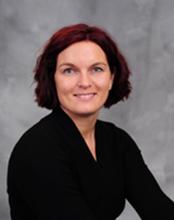
Virus Hunter
“Diversity helps us get out and see the light”
Working as a virologist at NIH’s Rocky Mountain Labs (RML) in Hamilton, Montana, is a joy for Dr. Andrea Marzi, in part because she’s been able to find a great work-life balance.
“Within 15 minutes after leaving work at my lab, I can be hiking or running with my dog, Willow, in some of the most scenic canyons in the country,” she says of her off-time in Montana’s beautiful Bitterroot Valley with her active 75-lb Lab-hound mix.
Admitting to being a former workaholic, Marzi considers RML a fulfilling place to do cutting-edge science while also staying sane. Selected for NIH’s Distinguished Scholars Program, Marzi sees NIH as an excellent venue for her research.
Part of NIH’s research system since the 1930s, RML was a “national vaccine factory” to protect soldiers against spotted fever, typhus, and yellow fever. Today, RML’s primary mission is basic scientific research on infectious diseases.
“I really love the fact that all NIH research is centered around human health,” Marzi says, adding that the stability of funding – especially for long-term projects – is particularly appealing since that stability is not common in most university labs.
Marzi has been in love with science, and viruses in particular, since she was a child growing up in a 50-home village in southern Germany.
“Viruses are all around us but they’re not alive!” she asserts. “How that can be true is something I’ve never been able to let go.”
What she means is that a virus cannot reproduce on its own. After infecting a cell from a host (a human, animal, or a plant), a virus commandeers a host cell to make thousands of identical copies of its genetic material (DNA or RNA) and viral proteins.
As a tenure-track intramural scientist for the National Institute of Allergy and Infectious Diseases’s RML, Marzi is dedicated to understanding how deadly viruses damage cells and their hosts, as well as how vaccines and drugs stimulate our immune system to protect us against viruses. She and her team have used animal models to develop promising antibody therapies and vaccines against Marburg virus, part of the filovirus family similar to the Ebola virus. This work in animals is essential before treatments and vaccines can be tested in people.
Developing therapeutic strategies and vaccines requires a lot of skill sets, and Marzi appreciates the value of diversity in her team as well as within the NIH Distinguished Scholars Program.
“As scientists, we can default to tunnel vision, and diversity helps us get out and see the light. It also gets me out of my comfort zone, which is important for discovery.”
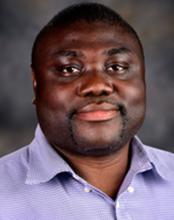
Living a Promise
“I inspire people of all backgrounds to be ambitious”
Dr. Benedict Anchang has never had an easy path to his current position as a tenure-track scientist in the National Institute of Environmental Health (NIEHS) Sciences intramural research program, but dogged persistence and a devotion to his mother helped a lot.
As Anchang tells it, despite an early passion and precocious ability for math and science, the odds against him were stacked. A native to Cameroon, he belonged to the largely marginalized Anglophone (English-speaking) minority in this central African nation that limited his earliest career opportunities. Then, tragedy struck, leaving his father to struggle financially to make ends meet when Benedict was just 18.
“My mum passed due to recurrent breast cancer, and one of her dying wishes was that I feed my passion for math and science,” he says.
Anchang’s father did what he could to honor his wife’s wishes, approaching a wealthy Cameroonian uncle to help support his son’s quest to become a scientist. But that strategy backfired. “Go and find a local teaching job, why do you need to go abroad or continue studying?” the uncle asked skeptically.
Undeterred – and tethered to his dying mother’s vision – Anchang relentlessly pursued his dream in scientific research that took him from college and graduate school in Europe to Stanford, California, for a postdoc, and then to NIH where he is today.
“Almost 20 years later, I only wish they were both still alive to celebrate the fruits of my persistence,” Anchang says.
His penchant for numbers led to a career in computational biology, which like bioinformatics uses computer-based methods to store and process biological data. With a joint appointment between NIEHS and the National Cancer Institute, Anchang is studying how mathematical modeling can untangle molecular nuances in tumors, consisting of many cancer cell “microtypes” that differ in seemingly tiny but potentially consequential ways.
Anchang developed a way to use computer algorithms to assess the effects of different cancer drugs – cell by individual cell – in a very fast, mechanized fashion, hoping to find better treatments for tough cancers.
Scientific worlds like the one Anchang lives in draw from the expertise of many different types of investigators, which he considers a recipe for scientific success. “NIH offers the chance to carry out high-quality research around very smart and supportive scientists and with people from diverse cultural backgrounds,” he says, adding that his own responsibility as a good mentor to trainees leverages this ethos.
“I try to inspire people of all backgrounds to be ambitious, which will lead to more innovation, reduce stereotypes, and increase our ability to solve complex problems.”
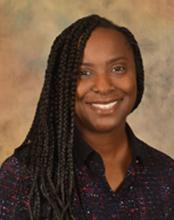
Change Agent
“I look for curiosity and grit in my lab recruits”
“Why do people do what they do?” Dr. Brenda Curtis wants to know, adding that daily decisions can have big consequences for health. A tenure-track intramural investigator with the National Institute on Drug Abuse, Curtis thinks most people “want to be well” but confront obstacles along the way. She believes understanding a person’s behavior in the moment is the best way to understand and predict what they’re likely to do next.
“Everyone is on their phone,” Curtis points out, “and everything is on there.” Where we go. What we buy. What music we listen to. What we say on social media.
Our online lives are routine predictors for product preferences – but what about our behaviors? Curtis, selected for NIH’s Distinguished Scholars Program, is leveraging this data. “It’s already being collected,” she says, to steer people with substance use disorder toward recovery. Twitter re-tweets, Facebook posts, and Snapchat stories can all be analyzed to monitor, predict, and even change human behavior, she explains.
Her research team is highly diverse scientifically – computer scientists, social workers, clinicians, students, counselors – and each contributes to the work in a distinct way based upon age, physical and intellectual ability, geographic background, and other features that describe all of us.
Everyone brings rich resources to the research environment. Noting that identity doesn’t imply representation, Curtis highlights,“I don’t speak for all African American women.” Nonetheless, individual characteristics can help people connect, which is important for her research. For example, someone with attention deficit hyperactivity disorder or anxiety might be able to facilitate an interview with a patient that shares either or both conditions and lead to better treatment outcomes.
Curtis looks for curiosity and grit in her lab recruits: two of her own personality features. Growing up in East St. Louis, Illinois – a city that has been devastated by poverty, drugs, and crime – she learned how to be resourceful: “I’m going to hustle and figure things out,” a skill that now enables her to find collaborators and make things happen.
Curtis’ background also steered her passion to work in addiction and in HIV/AIDS. “Growing up, my community was devastated by HIV/AIDS and the crack epidemic,” she says. “Everyone was dying of either drugs or violence, and I wanted to make it better by becoming a doctor.”
Ultimately, thanks to an amazing mentor (her “second mother”), Curtis eschewed medical school for public health, and then to a doctorate in communications – where she sees extraordinary opportunities to reach people in everyday life.
That’s where you’ll find her – listening in to the things people do to help them find the change they need and want.
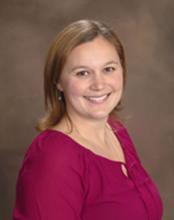
The World Inside Us
“I have an open-door policy”
Dr. Emily Vogtmann loves interacting with people. That’s one of the reasons she decided to pursue a career in epidemiology, which focuses on the health of people in the varied environments where they live and work.
As a tenure-track intramural investigator with the Division of Cancer Epidemiology and Genetics in the National Cancer Institute, who was recently selected for NIH’s Distinguished Scholars Program, Vogtmann admits to not even knowing what an epidemiologist was until she was in her 20s. Now, she sees it as the “perfect combination of my interest in lab research and studying human disease on a large scale.” Currently, her research focus is on the effects of the microbiome on cancer.
The microbiome is quite literally the world inside us that is not us. It is all the microorganisms that reside on or within our organs, which are thought to have an important impact on health and disease. The microbiome is highly variable between people and can change even within the same person across the span of a single day.
A range of different body fluids and tissues are needed to identify links between microbes or microbial DNA sequences and various health changes. Those measurements need to be combined and analyzed in the context of the multitude of other factors that affect our livelihoods, including: diet, chemical exposures, our own genomes, and sociocultural interactions.
To understand the microbiome, Vogtmann collects microbial DNA from individuals’ oral or fecal samples gathered in large, cohort studies involving thousands of research participants. Such sample collections can be tricky, so she relies on a diverse array of scientific and cultural expertise from team members to help her come up with recruitment methods and collection procedures acceptable to the diverse array of people that participate in these studies.
“It is exceedingly important to have representation of all individuals in microbiome studies to fully understand the impact of the microbiome on health and disease,” says Vogtmann.
Vogtmann believes the basic principles of inclusion are important for connecting with research participants as well as her laboratory staff. “I have an open-door policy so that people can come by my office and discuss anything that would help make them feel comfortable,” she says.
A new mother to a baby girl, Vogtmann has little time outside of work for herself, but she gets plenty of intellectual stimulation and social interaction at work.
“I meet with, hear from, and sometimes run into, accomplished NIH scientists and have so many opportunities to listen to talks from visiting scientists,” Vogtmann says.
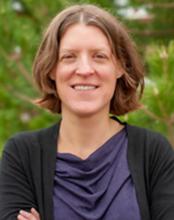
Outbreak Junkie
“Anyone who wants to pursue science should have an equal chance”
Virologist Dr. Emmie de Wit satisfies her curiosity – and love for finding order in the world around her – through basic lab research. But an explicit connection to people and public health is a must, and her everyday work at the National Institute of Allergy and Infectious Diseases’ (NIAID’s) Rocky Mountain Labs (RML) makes this possible.
During World War II, RML became a “national vaccine factory” to protect soldiers against spotted fever, typhus, and yellow fever. Since the 1930s, it has been part of NIH’s research system and today, RML’s primary mission is basic scientific research on infectious diseases.
Selected for NIH’s Distinguished Scholars Program, de Wit lives the NIH mission of turning discovery into health through her efforts to tame infectious diseases.
“I’m an outbreak junkie!” she admits, tracing her passion following the spread of infections back to her time pursuing her PhD. During this time, she tracked an avian flu outbreak in the mid-2000s. Later, at the height of the 2014-2015 Ebola epidemic, de Wit had the “opportunity of a lifetime” to run a diagnostic lab for 4 months in Monrovia, Liberia.
That experience with Ebola made her acutely aware of the need to work closely with developers of antiviral treatments at the earliest stage of an epidemic. de Wit learned about the value of a diverse team to connect research findings with effective approaches to slow the spread of disease.
But while diversity of perspectives and expertise is vital for navigating an emerging epidemic: to de Wit, fairness is even more important.
“Anyone who wants to pursue a career in science and has the talent for it should have an equal chance at making it,” she says. “How many people are missing out on such a great career for no good reason if we don’t provide them the opportunity?”
de Wit’s research centers on viruses that infect the lower respiratory tract. Examples of such viruses include those that lead to: the avian flu, the 2012 Middle East Respiratory Syndrome (MERS) outbreak, and the recent Corona Virus Disease 2019 (COVID-19) pandemic.
Her main research as an NIAID tenure-track intramural scientist focuses on the potentially deadly Nipah virus, which emerged as a serious threat in southeast Asia and for which there is currently no effective treatment or vaccine. She unwinds from the hard work involved in outwitting viruses by pursuing outdoor opportunities that abound amid the natural beauty of Montana’s Bitterroot Valley in RML’s backyard.
“Getting on my bike after work and riding through the beautiful Rocky Mountains helps me organize my thoughts and is super relaxing.”

Renaissance Woman
“At NIH, people collaborate instead of compete.”
As a child growing up in South Korea, Dr. Jiyeon Choi loved language and literature. Ultimately, she imagined becoming an interpreter and traveling the world.
Yet, Choi has always seen herself as independent and practical, so science seemed like a safer path to a successful living. Beginning in high school, she pursued a science track that led to a job with a biotech company after college. For 5 years, she was exposed to cutting-edge genomics and proteomics techniques and loved it.
“I developed a huge curiosity for learning more about the real biological questions behind these techniques,” she says. Afterwards, she decided to go to graduate school and “had an absolute blast!”
One thing led to another, and today Choi is a tenure-track intramural investigator in the National Cancer Institute’s Division of Cancer Epidemiology and Genetics, where she studies lung cancer—particularly in people who have never smoked. Those make up 10% to 20% of cases in the United States but much larger proportions in less-developed countries.
Genetics are known to be involved in lung-cancer susceptibility in both smokers and non-smokers based on evidence from family- and twin studies, as well as from case-control studies. Choi’s goal is to identify susceptibility genes and genetic variants contributing to lung-cancer risk and then link those genetic signatures to biological processes. Her hope is that understanding both will help prevent disease.
Although connecting with and understanding people better drives Choi’s love of human genetics, she is quick to note that her life as a researcher isn’t the only thing that defines her. Other passions include hiking, camping, and writing (she’s an occasional blogger) – as well as sampling and brewing craft beers and mixing cocktails for friends. Choi expects people in her lab to have different lives and diverse perspectives—something she sees as critical to creativity and problem-solving.
“Most discovery comes from connecting dots, so people with different experiences and personalities create synergy if they communicate well,” she says. Good communication is also central to being a good mentor, which is a high priority for Choi, who was selected for NIH’s Distinguished Scholars Program.
“I constantly try to find the best way to meet both the career goals of individual trainees as well as the scientific goals of my research group,” she explains.
In her own words, NIH’s biggest strength is its collegial environment. This helps a lot.
“At NIH, people collaborate instead of compete.”
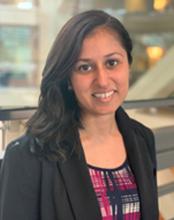
Cancer Be Gone
“I meet people where they are”
“There is amazing science going on around every corner – NIH is like the Hogwarts of science!” jokes Dr. Meera Murgai, referring to the fictional school for wizards in the popular Harry Potter novels.
A tenure-track intramural investigator for the National Cancer Institute’s Center for Cancer Research, Murgai is studying how cancer cells learn how to spread through a process known as metastasis. The question is one of the most important in the field of cancer, and it is also a long standing one. Scientists, who unearthed the 3,200-year-old archaeological remains of a young man in Africa, discovered evidence that his original cancer had spread throughout the body to multiple organs.
Murgai and her team have identified a cellular “enabler” contributing to metastasis, the tumor-spreading process responsible for up to 90% of cancer deaths.
One of the keys to metastasis, explains Murgai, is that cancer cells find refuge where they can. Her research has determined that tumors spit out molecules to recruit healthy cells near blood vessels embedded in connective tissue. These molecules turn healthy cells rogue, enabling them to nurture and protect cancer cells in new hiding places. There, she says, the cancer cells grow and multiply, metastasizing by forming tumor nodules in new organs.
Understanding the process of metastasis helps uncover new approaches to prevent these harmful micro-environments from forming, so traveling cancer cells aren’t protected—and can be attacked by medications or the body’s defenses.
Asking and answering the tough questions that might outmaneuver cancer is an investigative and imaginative activity for Murgai.
“Coming up with new ways to answer novel questions satisfies my creative side and determining which questions to ask – and what the answers might mean in the broader context of cancer progression – satisfies my analytical side.”
Recently selected for NIH’s Distinguished Scholar Program, Murgai has a strong commitment to mentoring. And to her, making people feel welcome seems straightforward and obvious.
“I try to meet people where they are – that means avoiding jargon that over-complicates my message when describing science.”
She considers good communication part of her job and goes out of her way to show it. “How can someone be excited and engaged about what we’re studying, if they’re intimidated or just doesn’t understand what’s going on?” she asks.
When Murgai isn’t not solving scientific problems or casting scientific ‘spells’ on cancer cells, she loves hanging out with friends and family. She went to high school, college, and graduate school in Virginia, and thus has lots of connections in the Washington, DC area.
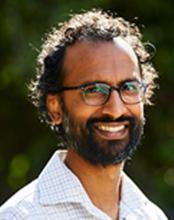
Engineering Success
“Diverse backgrounds bring attention to understudied challenges”
“Curious” is the word Dr. Meru Sadhu says best describes him, although his wife asserts that he is “thoughtful.” It’s clear that both personality features serve him well at NIH.
Sadhu is head of the National Human Genome Research Institute (NHGRI) Systems Biology and Genome Engineering section and was selected for NIH’s Distinguished Scholars Program. Like his colleagues in this program, Sadhu prioritizes mentoring, choosing to lead by example by being curious, enthusiastic, and optimistic – hoping the people working around him will “catch his spirit.”
As a tenure-track NHGRI intramural scientist, Sadhu is interested in how DNA scripts biology and behavior, and he leads a team of researchers pursuing similar questions. Inviting input from his team, and empathizing with trainees, he adds, provide a supportive environment for discovery.
Genome engineers are a hot commodity for a range of scientific pursuits, including devising new types of molecular therapies for various health conditions. Increasingly sophisticated approaches such as CRISPR (short for clustered, regularly interspaced, short palindromic repeats) enable scientists like Sadhu to edit DNA very precisely and purposefully, even in living organisms.
CRISPR is taking biomedicine by storm, showing a wide variety of applications ranging from conducting basic research to designing novel biotechnology drugs – and even treating diseases like cancer, sickle cell disease, and others.
Sadhu uses CRISPR in the research organism budding yeast, which: divides quickly, is inexpensive to grow, and is well-understood at the genetic level. He has developed clever genomic tools to direct editing to specific DNA locations in yeast, which allow him to rapidly and systematically attribute cause-and-effect between ‘building blocks’ of DNA and biological function.
He has pioneered approaches to read and edit giant stretches of DNA from several different yeast chromosomes, in parallel. This work has unearthed a new understanding about hundreds of yeast genes, many of which have counterparts in humans and thus teach us about health and disease in people.
Originally drawn to math in college, Sadhu learned that genetics had a lot of the same appeal. “In both, you start with very simple principles but generate incredible complexity,” he says. For him, doing undergraduate research sealed the deal.
“I loved the feeling of creating my own knowledge that no one had previously known.”
With a singular focus on research, Sadhu says, NIH is an exciting place to be, due the diversity of scientific interests and perspectives.
“The biomedical community will inevitably focus more on diseases and public health challenges that are familiar to the people doing the research and setting policy, so if those people are from diverse backgrounds, it can help bring attention to understudied challenges.”
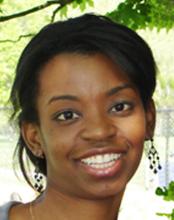
New Connections
“No problem is too trivial or unsolvable for this group”
“No problem is too trivial or unsolvable in this group,” says Dr. Michelle Antoine, of her peers in NIH’s Distinguished Scholars Program. She explains that the program provides a unique opportunity to interact frequently – and to learn and grow with a cohort of scientists at similar points in their careers.
Antoine, who is a tenure-track intramural investigator with the National Institute on Alcohol Abuse and Alcoholism, also enjoys the freedom and flexibility NIH offers to do high-risk, high-reward research. That’s in contrast to many academic labs, where she says she learned from peers that it’s common to have “secret” projects because resources are extremely limited. These risky projects can be seen as out of scope from the main research goals of a lab.
“Projects don’t have to stay concealed at NIH,” Antoine explains.
She is interested in understanding the brain’s ability to reshape its connections and functions at the level of synapses and whole circuits – its neuroplasticity. In particular, she wants to know how the wiring of our brain contributes to health problems as well as how it adapts to restore normal function after injury or disease.
Antoine’s past work has established causal relationships between abnormalities in sensation and various behavioral disorders, such as attention-deficit/hyperactivity disorder, anxiety, and autism. She just recently arrived at NIH and is setting up her new NIH lab, where she plans to study how plasticity at the synaptic and circuit level helps stabilize cortical network activity. She is studying how neural circuits get highjacked, and even rewired, by genetic abnormalities and environmental factors.
“Becoming a principal investigator requires perseverance, steadfast effort, and determination,” says Antoine. However, when she’s not doing science and has the time, Antoine likes to cook and travel. This may be a result of her childhood in the culturally vibrant Caribbean nation of Trinidad and Tobago, home to ethnically diverse traditions and cuisine.
Although her career trajectory has been impressive, garnering top awards and influential papers already, scientific success didn’t come instantly to Antoine. As a college student working in a lab, her experiments often didn’t work. But instead of giving up, Antoine dug deeper to find out why.
“I quickly realized that there was a logical reason for why an experiment worked or not, and I cared about discovering that reason,” she says.
She is also a firm believer in the value of diversity: “Biological problems are complex, and no one person has all the answers,” says Antoine. “Science thrives when people with common goals, but heterogenous perspectives and strengths, are encouraged to openly exchange their ideas.”

All Are Welcome
“I don’t assume anything – I just listen”
As a result of her “third-culture identity,” Dr. Nadine Samara has no trouble mixing in with just about any crowd. Born to Lebanese parents in New York City, Samara spent her formative years in Lebanon and Saudi Arabia. There, immersed in all kinds of cultural richness, she also saw more than her share of fighting—an unfortunate fixture of the Middle East. And she admits today that this experience likely accounts for her aversion to arguing, although “I do choose my battles carefully!”
She jokes that the combative local culture of her childhood didn’t stop her from sharing “endless, strong, opposing, rebellious opinions” with her parents, who nonetheless nurtured her independence and strength.
Building on the lessons from her past, today, as a tenure-track intramural investigator at the National Institute of Dental and Craniofacial Research, Samara does everything she can to be kind and welcoming to all. “I want my lab to be a place where people want to come to work every day to have fun doing science. I do everything I can to keep it a judgement-free, kind, and welcoming environment. All are welcome!”
When approaching anyone new, Samara immediately wants to connect: “I ask them general questions to learn more about their culture, their background, where they’re from, and I ask about questions about personal challenges. And I don’t assume anything – I just listen,” says Samara, who was selected for NIH’s Distinguished Scholar Program.
Samara’s career aspirations started with a love for chemistry but migrated after college to structural biology, a field dedicated to “seeing the invisible” molecules inside cells. Protein structures – often strikingly beautiful – provide essential data for understanding biology and in many cases serve as drug targets.
Because proteins are far too small to see with even a very powerful light microscope, structural biologists use sophisticated physics-based methods such as x-ray crystallography to visualize proteins.
Samara uses X-ray crystallography to study a diverse family of enzymes called glycosyltransferases–which influence host-microbe interactions–to find new medications that target antibiotic-resistant bacteria. Some of the proteins she studies affect the structure of biofilms: slimy communities of microbes, nucleic acids, proteins, and sugars that form on a wide array of surfaces ranging from river bottoms to medical implants. Biofilms can be difficult to treat with antibiotics.
When Samara isn’t in her lab or around NIH collaborating with and learning from scientists with diverse backgrounds and training, she tends to her two young daughters. She and her family love taking walks in their neighborhood or at nearby Rock Creek Park, as well as going to museums and markets.

Fighting Cancer from Within
“I am so lucky and honored to be at NIH”
“My patients and [their] families are the reason I do this,” says pediatric oncologist Dr. Nirali Shah, a tenure-track intramural investigator with the National Cancer Institute’s (NCI’s) Center for Cancer Research. She is a rising star in the world of cancer immunotherapy, an exciting field that’s delivering promise for patients with untreatable cancers.
With her father and her younger brother also being physicians, it is no surprise she was drawn to medicine from a young age. Shah has been so passionate about treating cancer that she considers pediatric oncology a calling. Her approach harnesses the power of a child or teen’s immune system to attack cancer from within, much like the body targets an infection. She uses adoptive cell therapy, a “living drug” created by several steps: removing a patient’s immune cells (killer T-cells), checking them for specific T-cell markers, then weaponizing the cells by attaching a chimeric antigen receptor, or “CAR,” specific to the patient’s tumor.
The process of making customized CAR-T cells takes about 7 to 10 days, after which the cells are injected back into her patient. “It’s a huge advantage to have easy access to NIH’s cell-manufacturing facility and an excellent team to make the cells,” says Shah.
Moreover, NIH’s research mission enables her to provide treatment while also working to improve cancer immunotherapy and figure new ways to conquer cancer in children whose cells don’t have the cell markers to respond to CAR-T therapy.
Shah’s compassion is matched with seemingly unbridled energy and a desire to “move things forward,” in her own words. Her approach to work-life balance is practical. “It’s hard to dissociate the two – it’s all just life. You do the best you can at any given moment, regardless of the setting.”
That’s an important perspective for a mother of three children aged 4 to 11 and a spouse who is also a busy professional. “We’ve used every possible type of childcare available and constantly adjust to the changing needs of our family.”
Shah doesn’t keep her personal and professional energy to herself. As NCI fellowship director of the NIH Pediatric Hematology-Oncology Fellowship program, she relishes the opportunity to mentor trainees, and work-life balance is a common topic. She believes that a good mentor considers what is important to supporting a “whole” person, asserting “You need to be personally happy in order to achieve professional success.”
Chosen for NIH’s Distinguished Scholar Program, Shah values diversity and inclusion and is thankful for the groundbreaking NIH program.
“I am so lucky and honored to be at NIH, where leadership is really ahead of the curve in prioritizing diversity and inclusion and promoting women and underrepresented minorities.”
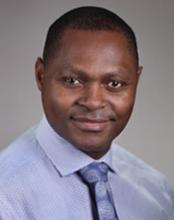
For the People
“Face-to-face interactions are always worth it”
People are at the heart of everything Dr. Sean Agbor-Enoh cares about.
A physician scientist, committed mentor, and father of four children ages 2 to 17, Agbor-Enoh is endlessly positive about work—and life in general.
“I am always eager to really get to know people,” he explains, whether that’s an end-stage lung-cancer patient under his care, a post-bac working in his lab, or a potential collaborator on a large research project.
“Face-to-face interactions are always worth it, and I go out of my way to meet people in person to make this happen,” says Agbor-Enoh, who was selected for NIH’s Distinguished Scholars Program.
Together with NIH Chief Officer of Scientific Workforce Diversity, Dr. Hannah Valantine, Agbor-Enoh has spent the past 4 years as a staff clinician with the National Heart, Lung, and Blood Institute (NHLBI), developing a sensitive and highly accurate blood test that can predict whether a lung-transplant recipient’s body will reject its new organ. The test picks up trace amounts of DNA from a donated lung that seep into the blood of a person whose body is in the process of rejecting its organ.
The basis for developing the test, Agbor-Enoh explains, is that the rejection method currently in use (biopsy) is expensive, highly invasive, and not always accurate. During a biopsy, a surgeon must enter the body and remove a piece of lung, then test it in the lab for signs of tissue damage and rejection. In contrast, the new blood test is quicker, more precise, and less costly.
Agbor-Enoh’s ultimate goal is to change the bleak odds for lung-transplant patients.
“Half of all transplanted lungs fail within 5 years, the highest for any transplanted organ,” he says. As an NHLBI tenure-track intramural scientist, Agbor-Enoh is currently determining whether early immune-suppression treatment after a positive lung-rejection test will help patients not only keep their organ but also live longer and healthier lives.
He and his research team have a daunting task ahead to process cell-free DNA, which is highly abundant in blood from lung-transplant recipients: about 10 billion DNA fragments in just one milliliter. But daunting isn’t really a word in Agbor-Enoh’s vocabulary.
“When I set my eyes on a mountain, I climb it!” he says, but Agbor-Enoh’s work is not about personal ambition. His infectious energy and compassion for others spreads easily among lab members and collaborators.
“We are extremely driven to make lives better for our patients,” he continued. “The intramural research program creates an unparalleled environment for us to achieve these goals.”

